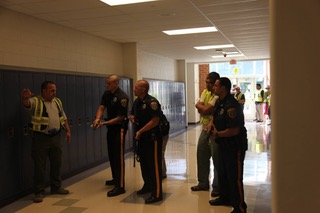We’re going to begin a multipart discussion on an uncomfortable topic, “Workplace Violence” in today’s post. Workplace violence can run the gamut of a co-worker or student having a bad day and barricading themselves in an office, to the more horrific events where knives, guns, explosive devices (simple M80 firecracker or pipe bomb to something larger), chemical weapons (something as basic as a pepper spray or other inhalation hazard or worse) to cause disruption and harm.
Over the years, Blazemark® has been used in many incidents. In particular, four “active shooter” events as security cameras or any IP addressable device is easily integrated into the application so that first responders can have “eyes on” the developing situation and having immediate access to building/occupant information easily at their fingertips.
The terms Site Security Plans, Emergency Action Plan, Emergency Response Plans are all components that feed Blazemark pre incident plans.
Here are some points to assess your facilities level of preparedness and to refine your thinking.:
- Assess the roles and effectiveness of coordination between public safety officials and your organization reacting to an adversarial event in accordance with existing plans and Standard Operating Procedures (SOPs) (e.g. Site Security Plans, Emergency Action Plans, Emergency Response Plans, Memorandums of Agreement, Memorandums of Understanding)
- Examine the effectiveness of overall emergency response procedures in a “no-notice” adversarial event regarding the Incident Command System (ICS) and logistical coordination among on-scene authorities.
- Examine and evaluate facility incident response plans (e.g. Site Security Plans, Emergency Action Plans, or other appropriate plans) used during an adversarial event.
- Assess the methods and effectiveness of internal and external communications during an adversarial event in accordance with existing plans and SOPs.
- Identify and evaluate response, mitigation, and recovery actions associated with an adversarial event at the facility.
- Review information, threat sharing procedures, and challenges between Federal, State and Local Governments to and from your organization.
- Identify gaps, redundancies, development activities, and best practices in standard procedures in response to an adversarial situation.
Does your organization have the necessary security capability to protect personnel and the facility during an incident while waiting for law enforcement to formally respond?
- Do facility incident response plans (e.g. Blazemark Preplans, Site Security Plans, Emergency Action Plans, Emergency Response Plans, or other appropriate plans) contain protocol for properly responding to incidents?
- Have security personnel been trained to provide guidance to employees for this type of incident?
- Are employees trained for this type of emergency incident? Is emergency contact information made available to the Security Center? Are procedures in place for sheltering-in-place versus evacuation?
- Are security personnel clearly identifiable upon arrival of law enforcement?
- Does your organization have notification systems in place to warn employees both on and offsite during such an incident?
- What instructions will be given to the employees (e.g. evacuation, shelter-in-place, lockdown)?
- Can security personnel assist in locating victims and assailants via closed-circuit television or similar capabilities?
- Are there access control capabilities at the facility in order to facilitate entry of first responders, prevent entry of visitors or additional employees, and manage contractors on site?
- Does the facility have the ability to remotely control access to critical components or activate/deactivate card readers, including the capability to deactivate a specific card?
- Is there appropriate emergency lighting capability at the facility to deal with a nighttime incident? How often is the emergency lighting tested?
Do State and Local Officials effectively coordinate to respond to an incident at your facility?
- Are the necessary Memorandums of Understanding and Memorandums of Agreement in place for external jurisdictions to assist in response efforts?
- Do Local, County, and State law enforcement have incident response plans (e.g. Site Security Plans, Emergency Action Plans, Emergency Response Plans, or other appropriate plans) for an active shooter situation? If so, who leads the response?
- What would State and Local officials need from your facility during an incident?
- How is emergency response coordinated?
- Are any of your facility incident response plans (e.g. Site Security Plans, Emergency Action Plans, Emergency Response Plans, Blazemark, or other appropriate plans) provided to first responders in preparation for potential incidents?
- Upon arrival of law enforcement, is there a “go bag” available to them containing desired items such as facility map/floor plans, access swipe cards, elevator keys, radios, etc.?
- Are there any safety concerns that need to be addressed (e.g., entering restricted or hazardous areas?
- How do emergency response personnel access the buildings? Is there a door numbering system in place?
- Have law enforcement/first responders participated in exercises and/or training at the facility? Do law enforcement/first responders have access to Blazemark?
- Do security personnel and first responders have interoperable radios/communication? Are plans in place for agencies to communicate if they cannot communicate via radio?
This is a complex subject to delve into and we’ll be positing more points to consider in future posts.


